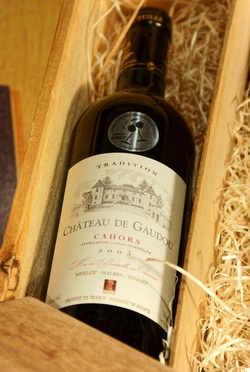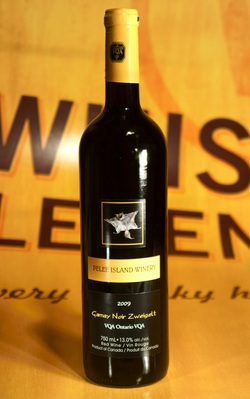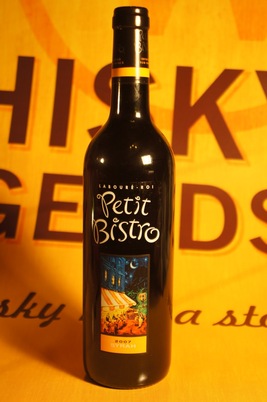
Fast Facts:
Bottled 2005
Origin: France, Cahors (Chateau du Gaudou) AOC
Bottle size: 750
13% Alc/Vol.
Just outside the Bordeaux region in France sits a small growing region known as the Vallée du Lot where the grapes are grown on very gravel-rich hillsides. In this valley is the AOC region of Cahors; a unique and pleasant Chateau known to world as Chateau du Gaudou (Shaw-t-o dew go-do).
On this estate winery they produce a rarity in French wines, it's not the grapes themselves that are necessarily unique, but the labeling practices are. You see, in more French regions wines are simply named for their geographical area. Laws on grape growing are very strict in France and quite often labeling wine as "Bordeaux" is enough to indicate what varietals are present. In Cahors, wines are sold with different blends of red grapes and they often have a break-down of the wine on the label.
This particular wine is made from 80% malbec, 15% merlot, and 5% tannat. This mix of grapes makes for a very interesting flavour profile. The malbec, being the dominant grape pushes through on the nose. It's distinct aroma of red-peppers fresh from the garden and earthy tones make this wine a great hearty-meal companion. The merlot adds a smoky subtlety to the freshness of the malbec. Merlot is known for it's body and in this wine it doesn't disappoint, adding a structural element that takes the wine away from a nearly bitter taste and mellowing it out on the tongue. The tannat, in my opinion is a filler grape. Much in the way Cabernet Franc is usually treated, the tannat grape is almost always undersold. It's debatable whether or not the tannat really adds much to he character of this wine at this time, but it is certain that it will help it keep it's appeal over time.
Bottled 2005
Origin: France, Cahors (Chateau du Gaudou) AOC
Bottle size: 750
13% Alc/Vol.
Just outside the Bordeaux region in France sits a small growing region known as the Vallée du Lot where the grapes are grown on very gravel-rich hillsides. In this valley is the AOC region of Cahors; a unique and pleasant Chateau known to world as Chateau du Gaudou (Shaw-t-o dew go-do).
On this estate winery they produce a rarity in French wines, it's not the grapes themselves that are necessarily unique, but the labeling practices are. You see, in more French regions wines are simply named for their geographical area. Laws on grape growing are very strict in France and quite often labeling wine as "Bordeaux" is enough to indicate what varietals are present. In Cahors, wines are sold with different blends of red grapes and they often have a break-down of the wine on the label.
This particular wine is made from 80% malbec, 15% merlot, and 5% tannat. This mix of grapes makes for a very interesting flavour profile. The malbec, being the dominant grape pushes through on the nose. It's distinct aroma of red-peppers fresh from the garden and earthy tones make this wine a great hearty-meal companion. The merlot adds a smoky subtlety to the freshness of the malbec. Merlot is known for it's body and in this wine it doesn't disappoint, adding a structural element that takes the wine away from a nearly bitter taste and mellowing it out on the tongue. The tannat, in my opinion is a filler grape. Much in the way Cabernet Franc is usually treated, the tannat grape is almost always undersold. It's debatable whether or not the tannat really adds much to he character of this wine at this time, but it is certain that it will help it keep it's appeal over time.




 RSS Feed
RSS Feed